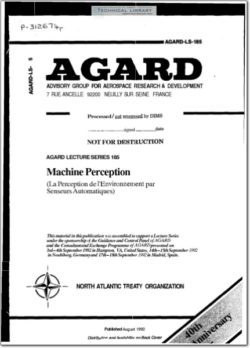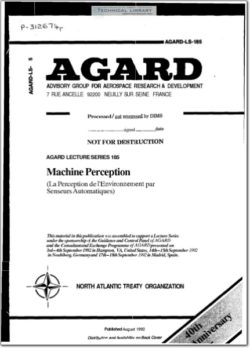AGARD-LS-185

- Version
- 45 Downloads
- 11.61 MB File Size
- 1 File Count
- April 26, 2016 Create Date
- April 26, 2016 Last Updated
Machine Perception

In airborne guidance and control both completely autonomous process control and autonomous knowledge-based
assistance for the pilot in process control are of prime interest, including autonomous situation assessment, planning
with decision-making and problem solving and execution services.
The lectures start on the first day with machine perception of speech, its recognition and understanding (Mangold).
This perceptual task is very essential for operator (crew) assistance in order to offer natural commmication means
human individuals are used to. The source of information to be perceived is the human being himself. Speech
productionisbasedon the specific sound generation which is possible using the articulatory organs. Man has developed
very special decoding and understanding mechanisms to extract from the speech signal all the information.
The remaining part of the lectures are exclusively devoted to vision, starting with approaches for sensing and
interpretationof 3 D shape and motion (Kanade) and elementary functions to be implemented on an electronic retina
(Zavidovique).
The capabilities and performance of vision systems using monocular stereo, and image sequence analysis with pixel
and feature processing will be discussed in the third lecture (Baker), as will their respective utilities to vision-based
autonomous guidance. The principal focus will be on the relationship between optic flow technique for image pair
analysis of motion and depth and spatio—temporalmanifold analysis.
The second day is more application-oriented. It starts with a lecture on3D vision application fornavigationandcontrol
of mobile robots (Garibotto). This contribution describes a binocular stereo vision module for obstacle detection with
no precise calibration at fastrate, atrinocular stereo vision based on segmentprimitives for the reconstruction of free
space for navigation, and landmark detection for self-positioningand orientation of the mobile vehicle.
The following contribution adresses image sequence understanding with application examples like road vehicle
guidancewith obstacle avoidance,vehicle docking and aircraft landing approach guidance (Dick”) . High-level
spatio—temporalmodels of the processes of interest in the real world are exploited for automatic feature tracking.
Other properties like feature grouping through ’Gestalt’idea, fixation-type vision, feature adaptation lo the actual
shape and feature selection in a situation context are incorporatedin this approach.
| File | Action |
|---|---|
| AGARD-LS-185 Machine Perception.pdf | Download |
Comment On This Post